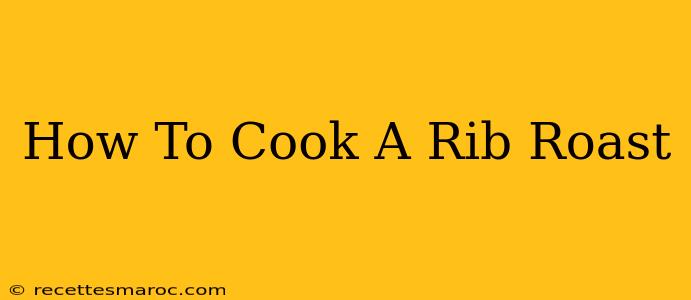A perfectly cooked rib roast is the centerpiece of any special occasion. Its rich flavor and tender texture make it a crowd-pleaser, but achieving that perfect result requires careful planning and execution. This comprehensive guide will walk you through every step, from selecting the right roast to achieving that beautiful, crispy exterior.
Choosing Your Rib Roast
The first step to a delicious rib roast is selecting the right cut. Rib roasts come in various sizes and grades, impacting both cooking time and final flavor.
- Grade: Look for a roast graded Choice or Prime for optimal marbling and tenderness. Prime will be more expensive but delivers superior flavor.
- Size: Consider the number of guests you're serving. A larger roast will require longer cooking time. Plan about 1 pound per person.
- Bone-in vs. Boneless: Bone-in roasts retain moisture better and offer a richer flavor, but boneless roasts cook faster and are easier to carve.
Preparing Your Rib Roast for Perfection
Before you even think about the oven, proper preparation is key to a succulent rib roast.
Seasoning is Key
- Simple is Best: A generous coating of salt and freshly ground black pepper is often all you need. Don't be afraid to be generous!
- Herbs & Spices: Elevate the flavor with herbs like rosemary, thyme, or garlic powder. You can also add a touch of onion powder or paprika. Avoid overly complex seasoning blends that could mask the natural flavor of the beef.
Letting it Rest
- Room Temperature: Allow the roast to come to room temperature (about 1 hour) before cooking. This ensures even cooking.
Cooking Methods: Oven Roasting vs. Reverse Sear
There are two primary methods for cooking a rib roast, each yielding slightly different results.
Oven Roasting: The Classic Approach
This method involves roasting the rib roast at a moderate temperature until it reaches the desired internal temperature.
- Temperature: Aim for 325°F (160°C).
- Cooking Time: This varies greatly depending on the size and weight of the roast. Use a meat thermometer to ensure accuracy. A general guideline is 15-20 minutes per pound for medium-rare.
- Basting: For an extra crispy exterior, baste the roast with pan drippings every 20-30 minutes.
Reverse Sear: For the Ultimate Crispy Crust
This method involves cooking the roast at a low temperature until almost fully cooked, then searing it at a high temperature for a perfect crust.
- Low Temperature Cook: Start by cooking the roast at a low temperature (around 225°F or 107°C) until it's almost done.
- High Temperature Sear: Once the internal temperature is close to your desired level, increase the oven temperature to 450°F (232°C) and sear for 10-15 minutes, or until the exterior is beautifully browned.
Checking for Doneness: The Importance of a Meat Thermometer
Never rely on visual cues alone. Use a meat thermometer to ensure your roast is cooked to your desired level of doneness.
- Rare: 125°F (52°C)
- Medium-Rare: 130-135°F (54-57°C)
- Medium: 140-145°F (60-63°C)
- Medium-Well: 150-155°F (66-68°C)
- Well-Done: 160°F (71°C)
Resting is Crucial
Once cooked, allow the roast to rest for at least 20-30 minutes before carving. This allows the juices to redistribute, resulting in a more tender and flavorful roast.
Serving Suggestions
A perfectly cooked rib roast is delicious on its own, but you can enhance it further with flavorful accompaniments. Consider serving it with:
- Yorkshire Pudding: A classic pairing for roast beef.
- Roasted Vegetables: Asparagus, potatoes, carrots, or Brussels sprouts all complement the rich flavor of the roast.
- Gravy: Make a flavorful gravy using the pan drippings.
- Horseradish Cream: Adds a spicy kick.
By following these steps, you can confidently cook a rib roast that will impress your guests and become a family favorite. Enjoy!

